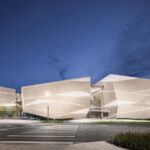The Chengdu Natural History Museum stands as a testament to science and culture, offering an immersive experience to visitors worldwide. Spanning 540,000 square feet (50,000 square meters), this architectural marvel serves as a significant cultural landmark in Chengdu, a city experiencing rapid economic growth as a high-tech and entrepreneurial hub. Completed in 2022, the museum embodies Chengdu’s historical legacy and modern vibrancy, reshaping its skyline and embodying its innovative spirit.

Inspired by Local Elements
The museum’s design draws inspiration from Chengdu’s rich heritage and natural surroundings, encapsulating the essence of “Shu Mountain, Shu Road, Shu Water.” It pays homage to the region’s geological formations, historical roads, and waterways, weaving these elements into its architectural narrative.
Form and Tectonics: Echoes of Shu Mountains
The massing of the building mirrors the rugged contours of the Sichuan mountains, reflecting the geological forces that shaped the Chengdu region. The volumes rise and shift, creating dynamic spaces that reveal public areas within while remaining grounded to the earth. Crafted from local granite, the exterior facade features organic perforations, reminiscent of snow-covered peaks during the day and illuminated stars at night.

Experience and Adventure: Embracing Shu Road
Inspired by the mountainous Shu Roads, the museum’s interior incorporates a Dino Box—a suspended pathway connecting different levels of the building. Visitors embark on an interactive journey, walking among dinosaur exhibits positioned along the path, suspended from the ceiling. This immersive experience evokes the spirit of adventure and exploration.
Transparent Connections: Glassy Intersections
Transparent clefts between the rock forms create visual and physical connections between exhibits, streets, and the surrounding landscape. These spaces encourage reflection, observation, and interaction, blurring the boundaries between the museum and its environment.

Water and Landscape: Reflecting Shu Water
The museum’s landscape pays homage to the historical Dongfeng Canal, incorporating waterways and reflecting pools throughout the site. Terraced gradients, adorned with diverse plant life, evoke the region’s agricultural heritage. Interactive water features add to the sensory experience, inviting visitors to engage with the museum’s surroundings.
Conclusion: Bridging Past and Present
The Chengdu Natural History Museum transcends its role as a mere institution, serving as a bridge between Chengdu’s past and future. By integrating local elements and embracing innovative design, it celebrates Chengdu’s cultural legacy while inspiring future generations to explore the wonders of science and nature.
















